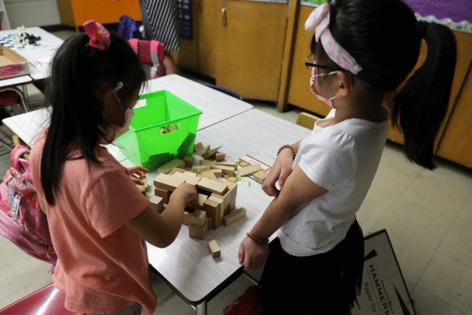NYC schools racing to reduce class sizes to spend $400 million, hire thousands of new teachers
Published in News & Features
NEW YORK — Ahead of a key deadline to reduce class sizes, New York City’s sprawling school system will spend upward of $400 million as it races to fill 3,700 new teaching positions by the fall, new data shows.
Under the state’s 2022 class size law, 60% of classrooms must comply next school year with caps between 20 and 25 students, depending on grade level. It’s expected to be the first time schools have to make real changes to abide by the regulation.
To meet that benchmark, principals developed and had approved 741 school-specific plans in exchange for more funding. Schools Chancellor Melissa Aviles-Ramos and her deputies revealed during a City Council hearing on Tuesday that costs associated with those plans will top $400 million, paid for with a combination of state and city funds.
While nearly all schools will use those dollars to bring on more teachers, some also expect to hire about 100 assistant principals or convert spaces into classrooms.
“We wanted to make sure that the impact was not felt at the school budget level, because they needed to meet this mandate,” Aviles-Ramos said. “And so when we say the plan, we meant a holistic plan that really, really captured all of the steps that would ensure the school can meet the mandate.”
Schools including Queens’ M.S. 158 Marie Curie in Bayside and Hillcrest High School in Jamaica were approved to hire as many as 31 and 23 additional teachers, according to a list of funded positions released later in the week. Other campuses will likely feel less of an impact from this year’s hiring push: About a third of schools were authorized for three or fewer new teachers.
Of the 81 schools who applied for room conversions, only 10 projects were “deemed feasible to date,” according to a citywide proposal issued alongside the list of schools. Principals could also ask to cut 3K or Pre-K sections to free up classroom space, but a schools spokeswoman declined to share how many of those requests were ultimately approved.
Olympia Kazi, a mom of two students at P.S. 187 in Washington Heights and the chief PTA member on efforts to lower class sizes, said the school is so overcrowded that it could only fit one more teacher — and had to give up an art room to make space available. It’s the second time P.S. 187 has to surrender a key facility: Before the art room was renovated for that purpose, it was a library, to which the school no longer has access.
“My kid had 30 kids in their class in first grade. I saw firsthand how impossible it is from every perspective — for the teacher, for kids,” Kazi said. “We need to invest in improving, and improving for real.”
Kazi called the plan “low-hanging fruit” and wished that three years after the law was passed, the city would have done more to cap enrollment at overcrowded schools, hire dedicated staffers for class size reduction, or otherwise think ahead.
“We did intentionally announce this early to give more teachers time to apply, since we’re getting close to doubling the number of teachers we usually hire,” Emma Vadehra, the chancellor’s deputy tasked with operations and finance, said at the Council hearing.
Some boroughs and school districts were more eager than others to apply for the funding to hire more teachers, according to the citywide proposal.
Schools in Queens applied for and are receiving funds to hire more than 1,280 additional teachers, and Brooklyn schools over 980 teachers, it showed. The Bronx and Manhattan will each get about half of the teachers awarded in next year’s plan as Queens received.
Vadehra cautioned that more hires are being made than usual in areas of lower economic need: “We did see more applications for more teachers from schools in our comparatively better-off communities,” she said.
School districts with the smallest shares of principals applying included Districts 4 in East Harlem and 12 in the central Bronx, according to the proposal. To encourage schools to apply, the spokeswoman said central office staffers scheduled sit-downs and trainings with district superintendents and principals to discuss the opportunity and answer any questions.
But the school system still has a long way to go until the law is fully phased in over the next few years.
Between backfilling positions and complying with the new caps, the city expects to hire upwards of 20,000 teachers between now and the start of the 2028-29 school year, according to new data in the proposal.
And beyond hiring, some advocates said the plan does not go far enough to address how 495 overcrowded schools — which do not have the space to lower class sizes in their current foot print — will meet the requirements of the law.
“We are now coming into the third year of what’s supposed to be a five-year plan, and yet the DOE is still dragging its feet,” said Leonie Haimson, executive director of the advocacy group Class Size Matters. “These schools enroll nearly half of students. Without a coordinated plan that includes an accelerated effort to build more schools, aligned with more rational enrollment policies, these students will never get the individualized attention from their teachers that they so desperately need.”
______
©2025 New York Daily News. Visit at nydailynews.com. Distributed by Tribune Content Agency, LLC.







Comments